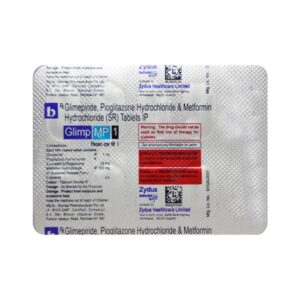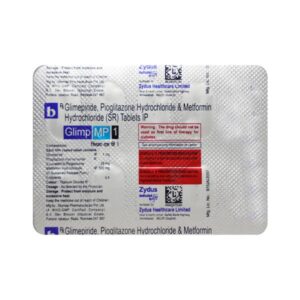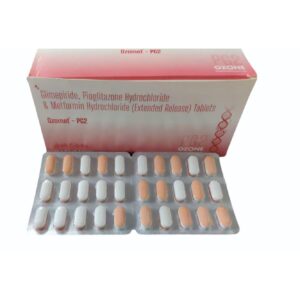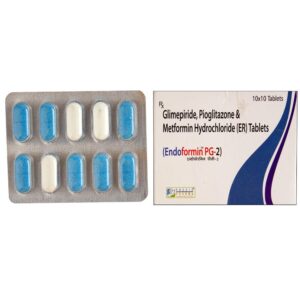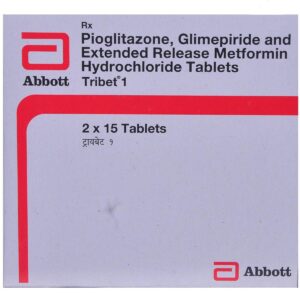GLIMEPIRIDE + METFORMIN + PIOGLITAZONE
Glimepiride: Glimepiride is an oral antidiabetic medication that contains the active ingredient glimepiride. It is primarily used to control blood sugar levels in people with type 2 diabetes.
The mechanism of action of Glimepiride involves stimulating the release of insulin from the pancreatic beta cells. It binds to specific receptors on these cells, leading to the opening of potassium channels and the subsequent influx of calcium ions. This process triggers the release of insulin into the bloodstream, which helps to lower blood sugar levels.
The recommended starting dose of Glimepiride is usually 1-2 milligrams once daily, taken with breakfast or the first main meal of the day. The dosage may be adjusted by a healthcare professional based on individual response and blood sugar levels. However, the maximum recommended daily dose is 8 milligrams.
Common side effects of Glimepiride may include hypoglycemia (low blood sugar), dizziness, headache, nausea, and weakness. Less frequently reported side effects include skin reactions such as rash or itching. It is important to be aware of the signs of hypoglycemia, such as sweating, tremors, confusion, and rapid heartbeat. In severe cases, hypoglycemia can lead to loss of consciousness, seizures, or even death. If any serious side effects occur, it is crucial to seek medical attention immediately.
It is important to note that Glimepiride should be used as part of a comprehensive treatment plan for diabetes management, which may include diet, exercise, and other medications. The drug should be taken regularly and as directed by a healthcare professional. It is essential to monitor blood sugar levels and follow up with a doctor to track progress and ensure optimal control of diabetes.
Metformin: Metformin is a medication commonly prescribed for the treatment of type 2 diabetes. It belongs to a class of drugs called biguanides, which work by reducing the amount of glucose produced by the liver and improving the body’s response to insulin.
The primary use of metformin is to control blood sugar levels in individuals with type 2 diabetes. It helps to lower the amount of sugar absorbed from food and reduces the amount of sugar produced by the liver. It also enhances the body’s sensitivity to insulin, which helps in the better utilization of glucose by cells.
The typical starting dose of metformin for adults is usually 500 mg or 850 mg taken orally once or twice per day with meals. The dosage can be gradually increased if needed, up to a maximum of 2,550 mg per day. It is important to follow the doctor’s instructions regarding dose and timing.
As with any medication, metformin may cause side effects. Common side effects include gastrointestinal symptoms such as nausea, diarrhea, vomiting, abdominal discomfort, and loss of appetite. These side effects usually subside over time as the body adjusts to the medication. Rare but serious side effects may include lactic acidosis, a buildup of lactic acid in the bloodstream, which can result in severe complications. Symptoms of lactic acidosis include weakness, tiredness, trouble breathing, unusual muscle pain, stomach discomfort, and dizziness.
It is crucial to inform your healthcare provider about any pre-existing medical conditions or medications you are taking before starting metformin. They can advise you on the appropriate use and help monitor any potential interactions or side effects.
Overall, metformin is an effective and commonly prescribed medication for the management of type 2 diabetes. It helps control blood sugar levels by reducing glucose production and improving insulin sensitivity. However, it is important to use this medication under medical supervision and report any adverse effects promptly to your healthcare provider.
Pioglitazone: Pioglitazone is a medication used to treat type 2 diabetes mellitus. It is sold under the brand name Actos. It belongs to a class of drugs called thiazolidinediones, which work by improving the body’s response to insulin, a hormone that regulates blood sugar levels.
Pioglitazone works by activating a specific receptor called peroxisome proliferator-activated receptor-gamma (PPAR-gamma). Activation of this receptor increases the sensitivity of cells to insulin, enhancing the uptake and utilization of glucose from the bloodstream, thereby lowering blood sugar levels.
The usual starting dose of pioglitazone is 15-30 mg once daily, which can be increased to a maximum dose of 45 mg per day if necessary. It is usually taken with or without food.
Like any medication, pioglitazone may cause side effects. Common side effects include weight gain, edema (swelling), headache, muscle pain, and upper respiratory tract infections. Some individuals may experience an increase in liver enzymes, so regular liver function tests are recommended. Pioglitazone may also cause hypoglycemia (low blood sugar), particularly when used in combination with other diabetes medications that can lower blood sugar levels. In rare cases, pioglitazone has been associated with an increased risk of bladder cancer, although the evidence for this is not conclusive.
It’s important to note that pioglitazone should not be used in patients with heart failure or a history of bladder cancer. Additionally, it is not recommended for use during pregnancy or breastfeeding. As with any medication, it is essential to discuss with a healthcare provider the potential benefits and risks before starting pioglitazone.


